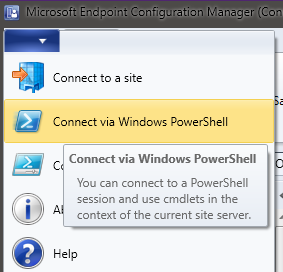PowerShell function that exports a Configuration Manager task sequence to an Excel sheet for documentation
The generated Excel sheet should be easy to read and navigate. Additional options are available to expand/collapse groups with macro-enabled buttons, which is good for nested task sequences.
- Powershell (tested on 5.1)
- Microsoft Excel (tested on 2019)
- Microsoft Endpoint Configuration Manager Console
- Ability to run unsigned scripts on your system
This shows you how to generate a simple Excel sheet by accessing the task sequence in a PowerShell session opened in the admin console. See More Examples for additional uses.
First, launch PowerShell from the admin console:
This script is unsigned, so you may need to temporarily change the execution policy to allow it.
PS> Set-ExecutionPolicy -Scope Process -ExecutionPolicy UnrestrictedDot source the script:
PS> . C:\Path\To\TSToExcel.ps1Get the task sequence and pipe it through Export-TSToExcel:
PS> Get-CMTaskSequence -Name "Task Sequence" | Export-TSToExcel -ShowThat's it! A progress bar should be visible in the PowerShell window and Excel should appear when it's finished.
Export-TSToExcel -Xml <XmlDocument> [-ExportPath <FileInfo>] [-TSName <String>] [-Show] [-Macro] [-Outline] [-HideProgress] [<CommonParameters>]
Export-TSToExcel -XmlPath <FileInfo> [-ExportPath <FileInfo>] [-TSName <String>] [-Show] [-Macro] [-Outline] [-HideProgress] [<CommonParameters>]
Export-TSToExcel -TaskSequence <Object> [-ExportPath <FileInfo>] [-Show] [-Macro] [-Outline] [-HideProgress] [<CommonParameters>]A task sequence object obtained from the Get-CMTaskSequence cmdlet. This is
also accepted as a pipeline.
The task sequence steps as a string or XML object. This can be obtained from
the Sequence property of a task sequence object.
The file path to a task sequence XML file.
The path to save the Excel file. This must end in .xlsx, or .xlsm for
macro-enabled files. If this is omitted, Excel will be shown after the sheet is
generated so you can save it manually.
The name of the task sequence that's displayed at the top of the Excel sheet.
This is obtained automatically from the -TaskSequence parameter, and should
be omitted if that's used. Otherwise, this will default to "Task Sequence" if
omitted.
Shows Excel after the sheet is generated.
Includes macro buttons to expand/collapse groups. See the example for more info.
Groups (outlines) rows in the Excel sheet so they can be expanded/collapsed without the use of macro buttons.
Hides the progress bar in the PowerShell window.
Generate an Excel sheet from a task sequence object (without using the pipeline), save it to the given path, and show it:
PS> $ts = Get-CMTaskSequence -Name "Task Sequence"
PS> Export-TSToExcel -TaskSequence $ts -ExportPath C:\ts.xlsx -ShowGenerate an Excel sheet from task sequence XML data with macro buttons, save it, and show it:
PS> $sequence = (Get-CMTaskSequence -Name "Task Sequence").Sequence # XML string
PS> Export-TSToExcel -Xml $sequence -TSName "Task Sequence" -Macro -ExportPath C:\ts.xlsm -ShowArrow buttons appear next to the group names. Clicking them will hide or show the contents of that group.
The workbook must be saved as a macro-enabled file, ending in the .xlsm
extension. Using .xlsx will result in an error.
This also requires access to the VBA object model. If access is not allowed (which is the default behavior), the script will prompt if it's okay to change a registry setting to allow access. You can also set this manually in Excel by navigating to File > Options > Trust Center > Trust Center Settings... > Macro Settings, and checking "Trust access to the VBA project object model". This will allow scripts and programs to modify and run macro scripts in Excel. Use wisely.
Generate an Excel sheet from a task sequence XML file with outlined groups, save it, and don't show the progress bar:
PS> (Get-CMTaskSequence -Name "Task Sequence").Sequence | Out-File C:\ts.xml
PS> Export-TSToExcel -XmlPath C:\ts.xml -TSName "Task Sequence" -Outline -ExportPath C:\ts.xlsx -HideProgressOutline groups in Excel can expand/collapse grouped rows.
They're less intuitive than the macro buttons, but don't require any special security permissions.
This script is released under the MIT License. See LICENSE.txt for more info.



